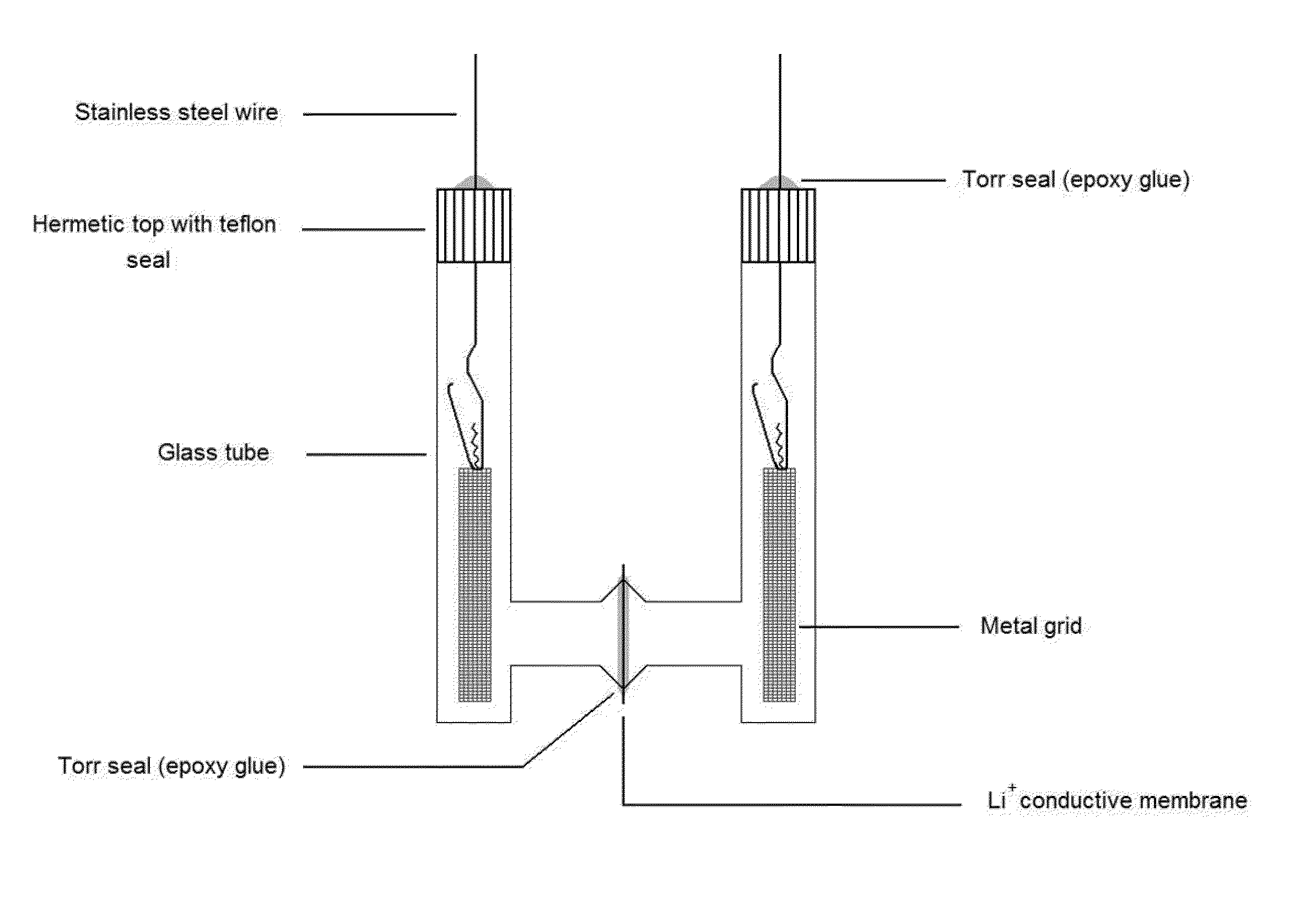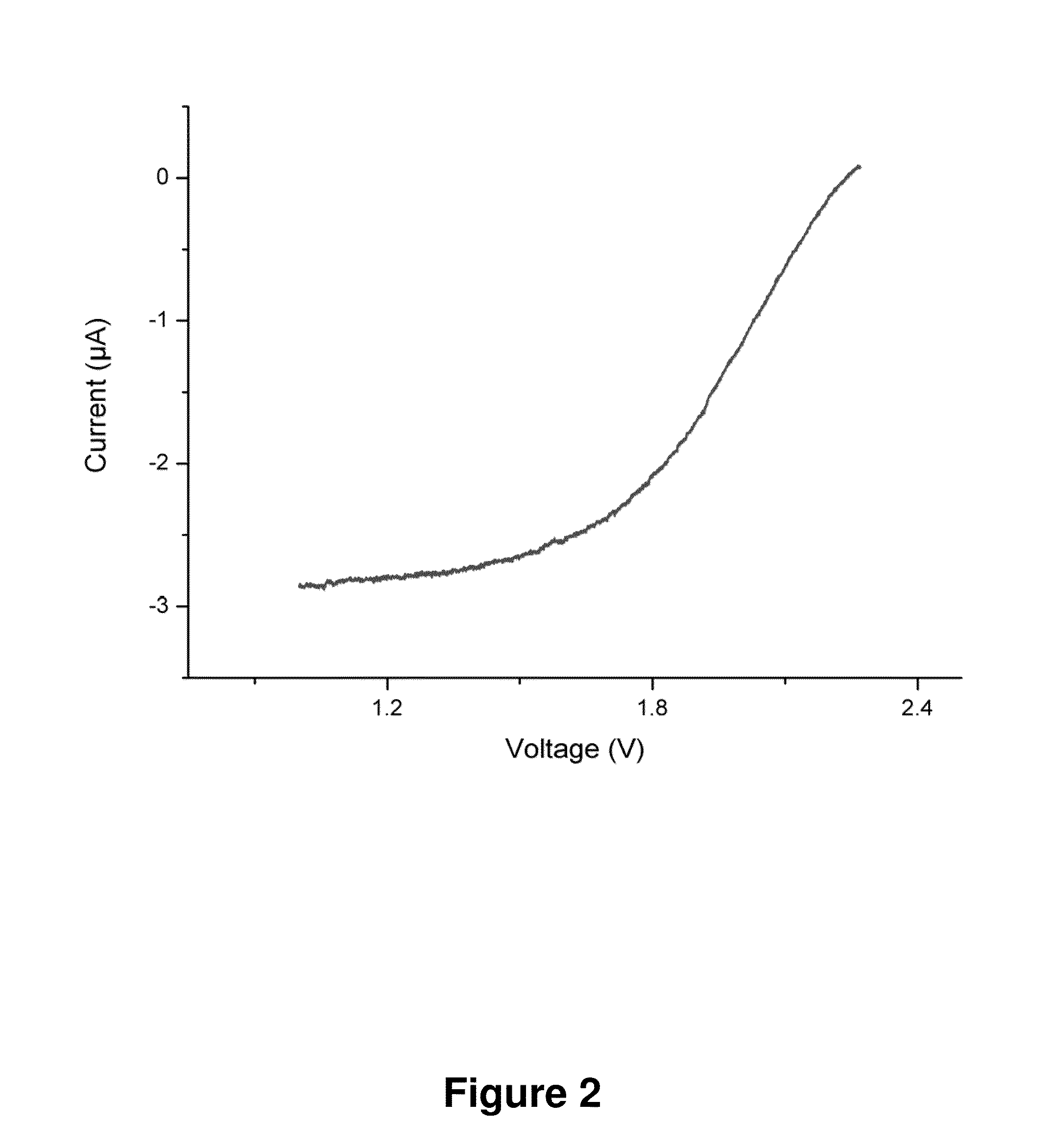Hybrid electrochemical generator with a soluble anode
a hybrid electrochemical and soluble anode technology, applied in the direction of indirect fuel cells, non-aqueous electrolyte cells, cell components, etc., can solve the problems of low cell voltage, substantial loss of specific energy achievable in these systems, and conventional state of the art dual intercalation lithium ion electrochemical cells are currently limited to providing average operating voltage, etc., to achieve efficient recharging and/or electrochemical cycling, high energy density, and high efficiency
- Summary
- Abstract
- Description
- Claims
- Application Information
AI Technical Summary
Benefits of technology
Problems solved by technology
Method used
Image
Examples
example 1
Liquid Alkali Metal Anode Cells
Principle
[0082]Alkali metals (AM) and other electron donor metal ions form solvated electron (SE) solutions with a variety of molecules, including polycyclic aromatic hydrocarbons (PAHs) such as naphthalene and organo radicals such as alkyl radicals. Many polycyclic aromatic hydrocarbons are solid at room temperature and, therefore, can be provided dissolved in a suitable solvent. Solvated electron complexes can be formed by dissolving the electron donor metal in a polycyclic aromatic hydrocarbon solution such as naphthalene in tetrahydrofuran. The solution takes a green-blue color characteristic of solvated electron complexes.
[0083]We used AM-PAH based solvated electron solutions as a working liquid anode for battery applications. The active cathode material in these systems can be as simple as air, water, MnO2 or more complex, such as LiMn1 / 3Ni1 / 3CO1 / 3O2 (LMNCO). The electrochemistry for cells having a soluble alkali metal in polycyclic aromatic hydr...
example 2
Realization of a Liquid Lithium Anode Cell
Principle
[0089]It is known that lithium can be dissolved in solutions containing polycyclic aromatic hydrocarbons such as naphthalene or biphenyl due to the high electron affinity of the polycyclic aromatic hydrocarbons. The reaction forming solvated electrons for both biphenyl and naphthalene are shown in eq. 12 and 13, below. Such lithium solutions, however, are not used in commercial electrochemistry applications because of their extreme reactive character and also the lack of useful resistant membranes which both separate the solvated electron solution from the cathode while at the same time allowing transfer of metal ions between the solvated electron solution and the cathode in a separate compartment.
2Li(metal)+biphenyl→[2Li+,(2e−,biphenyl)] (eq. 12)
2Li(metal)+naphthalene→[2Li+,(2e−,naphthalene)] (eq. 13)
[0090]Ohara Corporation has recently developed, and we have obtained, a new Lithium-Ion Conducting Glass-Ceramic (LIC-GC) membrane....
example 3
A Hybrid Electrochemical Generator with a Soluble Anode
[0114]Since their commercialization in the early 1990s lithium ion batteries (LIBs) have become the dominant electrical power source in most portable electronics such as cellular phones and laptop computers and are tested in automobile applications such as in hybrid cars, plug-in hybrids and electrical vehicles. The obvious advantage of lithium ion batteries compared to other battery chemistries is a high energy density of over 200 Wh / kg more than twice that of alkaline batteries and five times that of lead acid batteries [1]. Theoretical (maximum) energy density of current LIBs is in the order of 450 Wh / kg. On the other hand, primary (non rechargeable) lithium batteries using polycarbon monofluoride as the cathode material (Li / CFx) have demonstrated up to 650 Wh / kg. Therefore a compromise in energy density has been set vs. rechargeability. Here we introduce a new chemistry that allows for rechargeability and high energy density...
PUM
 Login to View More
Login to View More Abstract
Description
Claims
Application Information
 Login to View More
Login to View More - R&D
- Intellectual Property
- Life Sciences
- Materials
- Tech Scout
- Unparalleled Data Quality
- Higher Quality Content
- 60% Fewer Hallucinations
Browse by: Latest US Patents, China's latest patents, Technical Efficacy Thesaurus, Application Domain, Technology Topic, Popular Technical Reports.
© 2025 PatSnap. All rights reserved.Legal|Privacy policy|Modern Slavery Act Transparency Statement|Sitemap|About US| Contact US: help@patsnap.com



